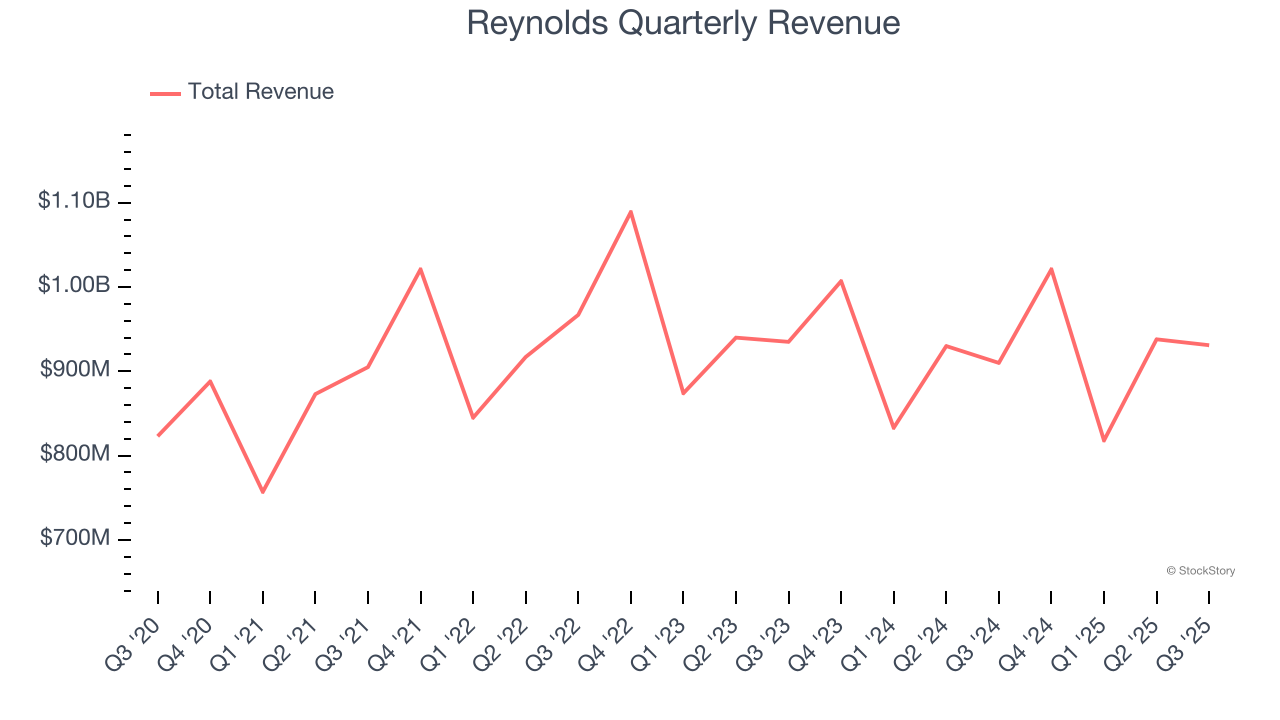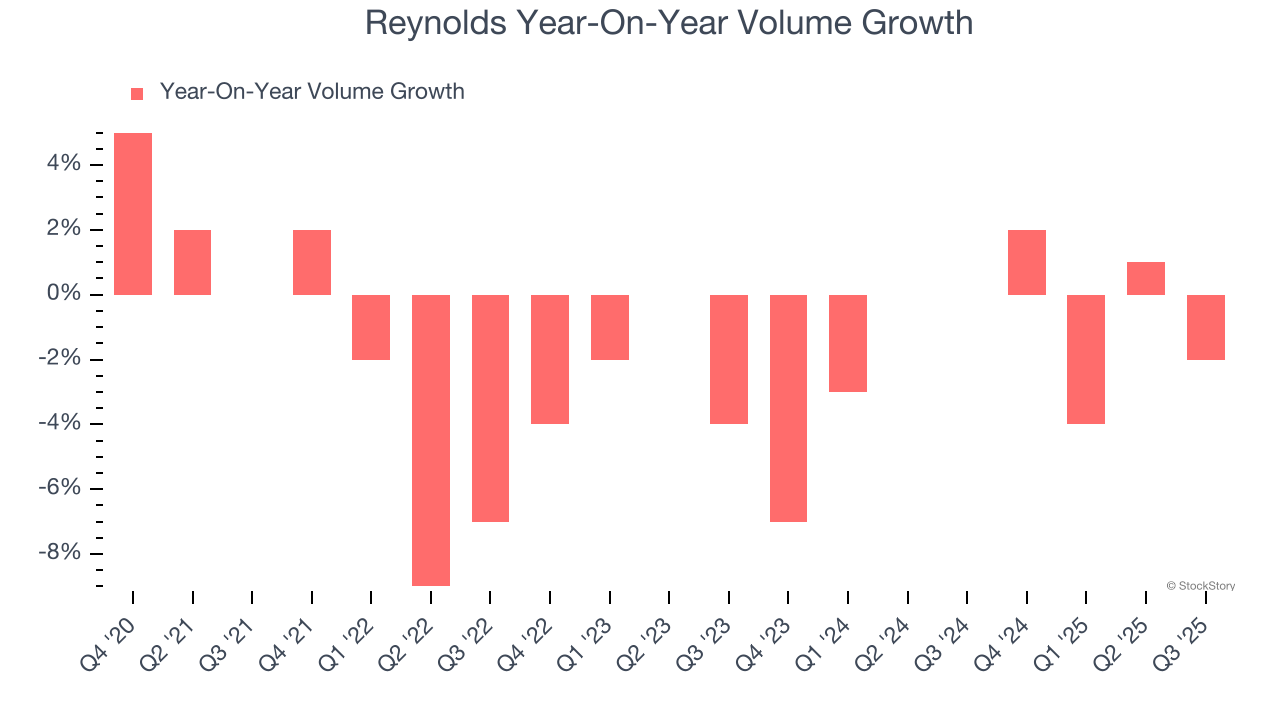
Household products company Reynolds (NASDAQ: REYN) reported revenue ahead of Wall Streets expectations in Q3 CY2025, with sales up 2.3% year on year to $931 million. On top of that, next quarter’s revenue guidance ($1.05 billion at the midpoint) was surprisingly good and 6.3% above what analysts were expecting. Its non-GAAP profit of $1.05 per share was significantly above analysts’ consensus estimates.
Is now the time to buy Reynolds? Find out by accessing our full research report, it’s free for active Edge members.
Reynolds (REYN) Q3 CY2025 Highlights:
- Revenue: $931 million vs analyst estimates of $900.8 million (2.3% year-on-year growth, 3.4% beat)
- Adjusted EPS: $1.05 vs analyst estimates of $0.39 (significant beat)
- Adjusted EBITDA: $168 million vs analyst estimates of $165 million (18% margin, 1.8% beat)
- Revenue Guidance for Q4 CY2025 is $1.05 billion at the midpoint, above analyst estimates of $989.7 million
- Management raised its full-year Adjusted EPS guidance to $1.62 at the midpoint, a 2.9% increase
- EBITDA guidance for the full year is $660 million at the midpoint, above analyst estimates of $653.4 million
- Operating Margin: 13.2%, down from 15.2% in the same quarter last year
- Free Cash Flow Margin: 5.2%, down from 10.2% in the same quarter last year
- Organic Revenue rose 2% year on year vs analyst estimates of 1.1% declines (308.7 basis point beat)
- Sales Volumes fell 2% year on year (0% in the same quarter last year)
- Market Capitalization: $4.98 billion
“Our people, brands and products are winning in a challenging environment, with all four business units delivering improved results driven by share gains in the majority of our categories,” said Scott Huckins, President and Chief Executive Officer.
Company Overview
Best known for its aluminum foil, Reynolds (NASDAQ: REYN) is a household products company whose products focus on food storage, cooking, and waste.
Revenue Growth
A company’s long-term sales performance is one signal of its overall quality. Any business can have short-term success, but a top-tier one grows for years.
With $3.71 billion in revenue over the past 12 months, Reynolds carries some recognizable products but is a mid-sized consumer staples company. Its size could bring disadvantages compared to larger competitors benefiting from better brand awareness and economies of scale.
As you can see below, Reynolds struggled to increase demand as its $3.71 billion of sales for the trailing 12 months was close to its revenue three years ago. This is mainly because consumers bought less of its products - we’ll explore what this means in the "Volume Growth" section.

This quarter, Reynolds reported modest year-on-year revenue growth of 2.3% but beat Wall Street’s estimates by 3.4%. Company management is currently guiding for a 3% year-on-year increase in sales next quarter.
Looking further ahead, sell-side analysts expect revenue to remain flat over the next 12 months. This projection is underwhelming and implies its newer products will not lead to better top-line performance yet.
Today’s young investors won’t have read the timeless lessons in Gorilla Game: Picking Winners In High Technology because it was written more than 20 years ago when Microsoft and Apple were first establishing their supremacy. But if we apply the same principles, then enterprise software stocks leveraging their own generative AI capabilities may well be the Gorillas of the future. So, in that spirit, we are excited to present our Special Free Report on a profitable, fast-growing enterprise software stock that is already riding the automation wave and looking to catch the generative AI next.
Volume Growth
Revenue growth can be broken down into changes in price and volume (the number of units sold). While both are important, volume is the lifeblood of a successful staples business as there’s a ceiling to what consumers will pay for everyday goods; they can always trade down to non-branded products if the branded versions are too expensive.
To analyze whether Reynolds generated its growth (or lack thereof) from changes in price or volume, we can compare its volume growth to its organic revenue growth, which excludes non-fundamental impacts on company financials like mergers and currency fluctuations.
Over the last two years, Reynolds’s average quarterly volumes have shrunk by 1.6%. This isn’t ideal for a consumer staples company, where demand is typically stable. In the context of its 1.9% average organic sales declines, we can see that most of the company’s losses have come from fewer customers purchasing its products.

In Reynolds’s Q3 2025, sales volumes dropped 2% year on year. This result represents a further deceleration from its historical levels, showing the business is struggling to move its products.
Key Takeaways from Reynolds’s Q3 Results
It was good to see Reynolds beat analysts’ revenue and EPS expectations this quarter. We were also glad its revenue guidance for next quarter trumped Wall Street’s estimates. On the other hand, its gross margin missed. Overall, we think this was a decent quarter with some key metrics above expectations. The stock traded up 1.6% to $24.10 immediately after reporting.
Reynolds had an encouraging quarter, but one earnings result doesn’t necessarily make the stock a buy. Let’s see if this is a good investment. The latest quarter does matter, but not nearly as much as longer-term fundamentals and valuation, when deciding if the stock is a buy. We cover that in our actionable full research report which you can read here, it’s free for active Edge members.





